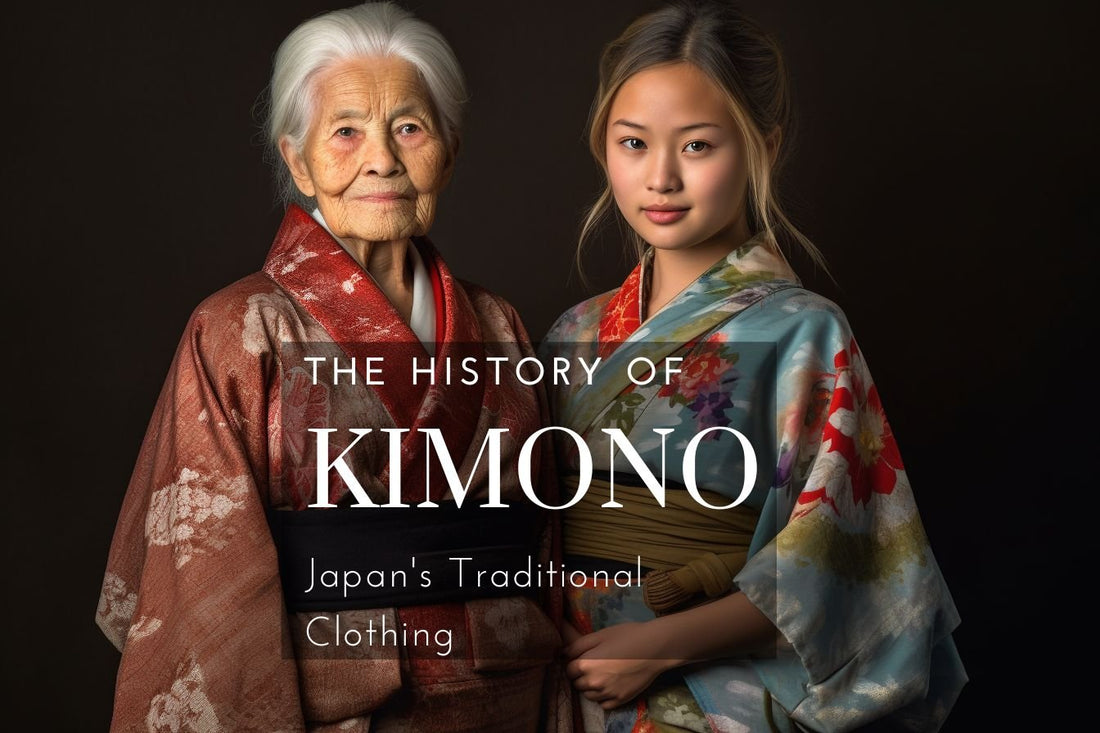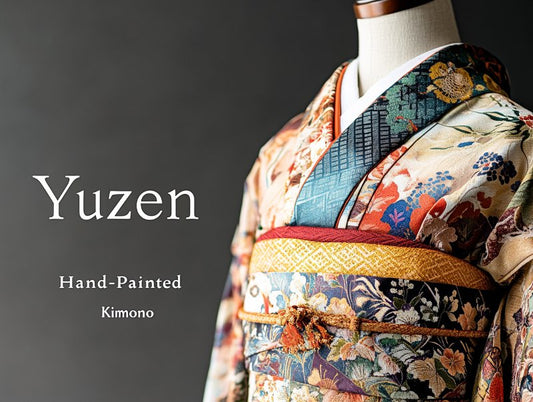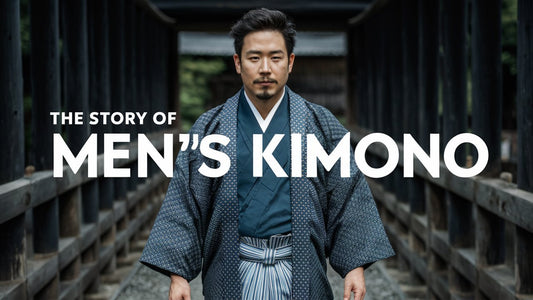
The History of Kimonos
Share
Introduction to Kimonos
Kimonos, the traditional Japanese garments, have a captivating history that spans centuries. The word "kimono" 着物 itself means "thing to wear" in Japanese, highlighting its fundamental role as a garment.
These elegantly crafted robes, with their vibrant patterns and unique cultural significance, continue to fascinate people worldwide. In this article, we will explore the intriguing journey of kimonos, examining their origins, evolution, symbolism, and enduring presence in popular culture.
Origins of Kimonos
The origins of kimonos can be traced back to ancient China, where similar garments called hanfu were worn.

During the 8th century, these influences reached Japan, giving rise to the basic structure of kimonos. Initially, kimonos were reserved for the elite and boasted highly stylized designs.
As Japan embraced its own distinct culture, kimonos underwent a transformation, becoming an integral part of Japanese identity.
Evolution of Kimonos
Early Kimono Styles
The Heian period (794-1185) marked a significant turning point for kimonos. They became more refined and gained popularity among the nobility. Crafted from luxurious silk, these kimonos featured intricate embroideries, reflecting the artistry and wealth of their wearers. The colors and designs held profound symbolic meaning, often representing the wearer's social status, rank, and even the season.
Influence of the Samurai
The rise of the samurai class had a profound impact on the evolution of kimonos in the following centuries. The samurai favored simpler and more practical designs, emphasizing functionality and ease of movement on the battlefield. Kimonos during this period boasted subdued colors and minimalistic patterns, aligning with the samurai's values of discipline and austerity.
Kimonos in the Edo Period
The Edo period (1603-1868) marked a significant shift in the design and popularity of kimonos. With the stabilization of the government and the growth of urban centers, a new middle class emerged, comprising merchants and artisans. This led to a surge in demand for kimonos, and the textile industry flourished. Kimonos became more accessible, and a wider variety of styles and patterns became available, reflecting the evolving tastes and preferences of the growing urban population.

Modernization and Western Influences
In the late 19th century, Japan opened its doors to the Western world, drastically impacting traditional clothing styles. Western fashion trends began to influence the design of kimonos, resulting in a fusion of traditional and modern elements.

The introduction of new materials, such as cotton and synthetic fibers, revolutionized the production of kimonos. Western-inspired tailoring techniques and patterns made their way into kimono designs, catering to a more
globalized and diverse audience.
Symbolism and Meaning
Kimonos are not merely garments; they are infused with deep symbolism and meaning, reflecting the values and cultural heritage of Japan. The colors, patterns, and motifs used in kimonos hold profound significance and convey messages about the wearer and the occasion. Let's explore some specific examples of symbolism in kimonos:
Colors and Patterns
i. Red: Red is a vibrant and auspicious color in Japanese culture. It symbolizes happiness, celebration, and good luck. Red kimonos are often worn during joyous occasions such as weddings, festivals, and New Year celebrations. The color red also represents vitality and energy.

ii. White: White is associated with purity, innocence, and new beginnings. It is often worn during important ceremonies, including weddings, tea ceremonies, and religious rituals. White kimonos are also worn by the bride in traditional Japanese weddings, symbolizing her purity and the start of a new chapter in life.

iii. Cherry Blossoms: The delicate and ephemeral cherry blossoms hold great significance in Japanese culture. They symbolize the transience of life and the beauty of nature. Kimonos adorned with cherry blossom patterns evoke a sense of fleeting beauty and are often worn during springtime events and hanami (cherry blossom viewing) gatherings.

iv. Dragons: Dragons have a strong presence in Japanese folklore and symbolism. In kimono designs, dragons represent power, strength, and good fortune. The intricate and detailed dragon patterns on kimonos signify protection and prosperity, and they are often worn during auspicious occasions and festivals.

Kimonos for Special Occasions
Kimonos hold specific meanings when worn for different occasions:
i. Wedding Kimonos: Traditional Japanese weddings feature elaborate kimonos, such as the "uchikake" and the "shiro-muku." The uchikake is a heavily embroidered kimono worn as a coat over a white wedding kimono.

The embroidery often includes symbols of good luck, such as cranes, pine trees, and flowers. The shiro-muku, a pure white wedding kimono, represents the bride's purity and is accompanied by accessories like a white hood and a white fan.
ii. Tea Ceremony Kimonos: The tea ceremony, a highly ritualistic and revered practice, has its own style of kimono. The tea ceremony kimono is often a subdued and elegant kimono in colors like gray, muted greens, or browns. These kimonos represent simplicity, humility, and harmony with nature, reflecting the principles of the tea ceremony.

iii. Festive Kimonos: Festivals in Japan showcase vibrant and festive kimonos. Each festival has its unique kimono style and patterns associated with it. For example, during the Gion Festival in Kyoto, women wear "yukata" kimonos with colorful and playful designs, while men wear "happi" coats adorned with festival symbols. These kimonos not only celebrate the event but also evoke a sense of community and cultural pride.
The symbolism and meaning behind kimonos extend beyond these examples, with countless variations and styles reflecting different aspects of Japanese culture, nature, and traditions. Kimonos serve as a visual representation of the rich heritage and values deeply rooted in Japanese society.
Kimonos in Popular Culture
Kimonos have not only influenced Japanese culture but have also left a lasting impact on various aspects of popular culture globally.
Kimonos in Japanese Art
Throughout history, kimonos have been a prominent subject in Japanese art, including paintings, woodblock prints, and ukiyo-e. These artworks not only showcase the beauty of the garments but also provide insights into the fashion trends of different eras.

Renowned artists like Kitagawa Utamaro and Utagawa Hiroshige have depicted people adorned in intricate kimonos, capturing the essence of traditional Japanese aesthetics.
Kimonos in Fashion
In recent years, kimonos have transcended their traditional boundaries and gained popularity worldwide as fashionable attire. Many fashion designers have incorporated elements of kimonos into their collections, adapting them to modern tastes.

Kimono-inspired robes, dresses, and accessories have become staples in both casual and high-end fashion, celebrating the timeless elegance and artistic craftsmanship of this iconic garment.
Preservation and Revival
In an era of globalization, there has been a renewed interest in preserving traditional crafts and cultural heritage. Various organizations and individuals are working tirelessly to promote the art of kimono-making and ensure its continuity.
Efforts are being made to educate younger generations about the significance of kimonos and encourage their appreciation through workshops, exhibitions, and cultural events. Furthermore, the revival of traditional dyeing and weaving techniques ensures the preservation of authentic craftsmanship and supports local artisans.
The history of kimonos is a testament to the enduring beauty and cultural significance of these traditional Japanese garments. From their ancient origins to their evolution through the centuries, kimonos have remained a symbol of elegance, craftsmanship, and cultural identity. Today, they continue to captivate people with their timeless charm, both in Japan and across the globe.
---
## FAQs about Kimonos
**1. Can men wear kimonos?**
Absolutely! Kimonos are not limited to a specific gender. Traditional formal men's kimonos, called "montsuki," are often worn for formal occasions such as weddings, ceremonies, and cultural events.
**2. Are kimonos only worn in Japan?**
While kimonos originated in Japan, they have transcended borders and are appreciated by people all over the world. They have become popular as a fashion statement and are often seen at cultural events and special occasions even outside of Japan.
**3. How long does it take to make a kimono?**
The time required to make a kimono varies depending on various factors, including the complexity of the design, the skill of the craftspeople involved, and the use of traditional techniques. It can take several weeks to months to create a single kimono, with each intricate detail carefully crafted by skilled artisans.
**4. Are kimonos expensive?**
The price of a kimono can vary greatly depending on several factors, such as the quality of the fabric, the intricacy of the design, and the craftsmanship involved. High-quality kimonos made from silk and featuring elaborate patterns and embroideries can be quite expensive, reflecting the skill and artistry required to create them.
**5. How should I care for a kimono?**
Kimonos should be handled with care to ensure their longevity. It is recommended to have them cleaned by professionals experienced in handling delicate fabrics. Additionally, proper storage in a cool, dry place, away from direct sunlight, is crucial to preserve the fabric and colors of the kimono. Following specific care instructions provided for each kimono is essential to maintain its beauty and quality.


